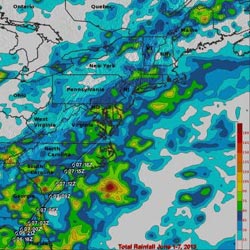NASA's TRMM Satellite sees Andrea's heavy rains in Cuba, US East Coast

TRMM rainfall amounts (June 1-7) along Andrea's track (shown by the white line connecting the storm symbols) were between 45 and 90 mm (~2 to 4 inches, shown in darker blue and green, respectively; with locally high amounts from around 100 mm (~4 inches, shown in yellow) to around 150 mm (~6 inches, shown in red) over parts of South Carolina, eastern Georgia, and coastal North Carolina.<br><br>Credit: Credit: SSAI/NASA Goddard Space Flight Center, Hal Pierce<br>
This trough extended out over the Gulf from the Yucatan Peninsula and provided the focus for the development of showers and thunderstorms in the region, eventually leading to the formation of Tropical Storm Andrea.
With its suite of passive microwave and active radar sensors, the Tropical Rainfall Measuring Mission or TRMM satellite is ideally suited to measure rainfall from space. TRMM is a joint mission between NASA and the Japanese Space Agency.
For increased coverage, TRMM is used to calibrate rainfall estimates from other additional satellites. The TRMM- based, near-real time Multi-satellite Precipitation Analysis (TMPA) at the NASA Goddard Space Flight Center in Greenbelt, Maryland is used to estimate rainfall over a wide portion of the globe.
At NASA Goddard, the TMPA rainfall totals were calculated for the eastern Gulf and the surrounding region for the period 1-7 June 2013, covering the time before Andrea formed until it was passing through eastern North Carolina. The calculations were mapped on an image at NASA Goddard. The TRMM data showed rainfall totals on the order of 400 to 500 mm (~16 to 20 inches) stretching from the eastern tip of the Yucatan to western Cuba and over the southeast Gulf of Mexico. Upwards of 600 mm (~24 inches) occurred offshore over the Yucatan Straight. There were reports of widespread flooding over western Cuba but no injuries.
Elsewhere, amounts over South Florida are on the order of 100 to 200 mm (~4 to 8 inches), while amounts over northern Florida are generally on the order of 100 mm (~4 inches) or less.
As Andrea moved northward up the United States' east coast, it began to accelerate as it transitioned into an extra-tropical system. Because of this, rainfall amounts were significantly lighter. A second image created at NASA Goddard showed TMPA rainfall totals for the eastern U.S. for the same period (June 1 through 7). In general, rainfall amounts along Andrea's track were between 45 and 90 mm (~2 to 4 inches) with locally high amounts from around 100 mm (~4 inches to around 150 mm (~6 inches) over parts of South Carolina, eastern Georgia, and coastal North Carolina.
Text credit: Steve Lang
SSAI/NASA Goddard Space Flight Center
Media Contact
More Information:
http://www.nasa.govAll latest news from the category: Earth Sciences
Earth Sciences (also referred to as Geosciences), which deals with basic issues surrounding our planet, plays a vital role in the area of energy and raw materials supply.
Earth Sciences comprises subjects such as geology, geography, geological informatics, paleontology, mineralogy, petrography, crystallography, geophysics, geodesy, glaciology, cartography, photogrammetry, meteorology and seismology, early-warning systems, earthquake research and polar research.
Newest articles

Security vulnerability in browser interface
… allows computer access via graphics card. Researchers at Graz University of Technology were successful with three different side-channel attacks on graphics cards via the WebGPU browser interface. The attacks…

A closer look at mechanochemistry
Ferdi Schüth and his team at the Max Planck Institut für Kohlenforschung in Mülheim/Germany have been studying the phenomena of mechanochemistry for several years. But what actually happens at the…

Severe Vulnerabilities Discovered in Software to Protect Internet Routing
A research team from the National Research Center for Applied Cybersecurity ATHENE led by Prof. Dr. Haya Schulmann has uncovered 18 vulnerabilities in crucial software components of Resource Public Key…




















